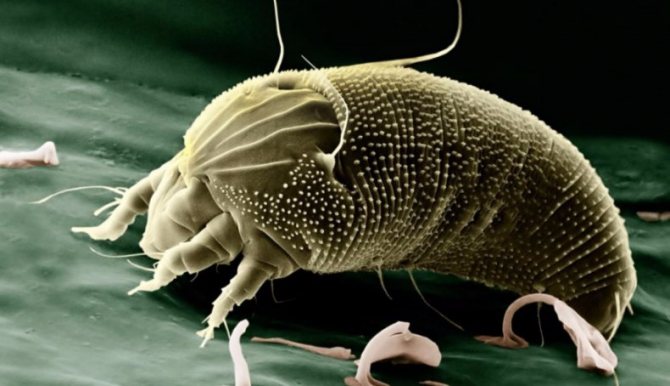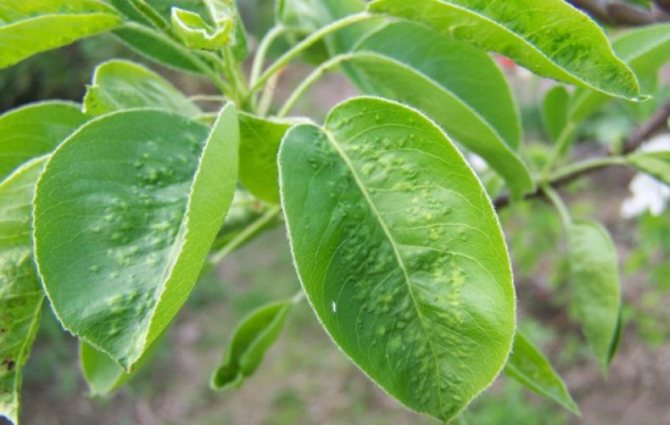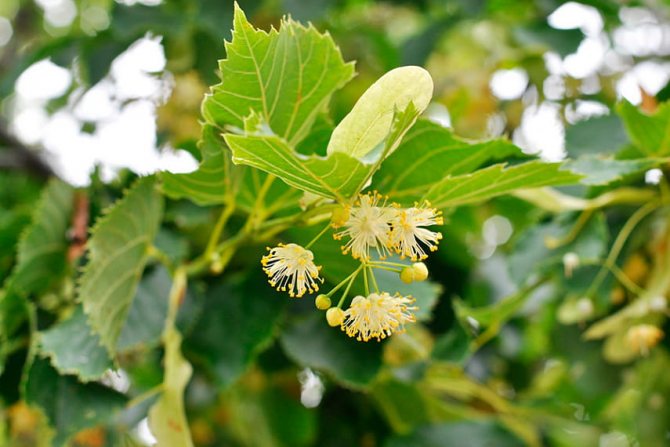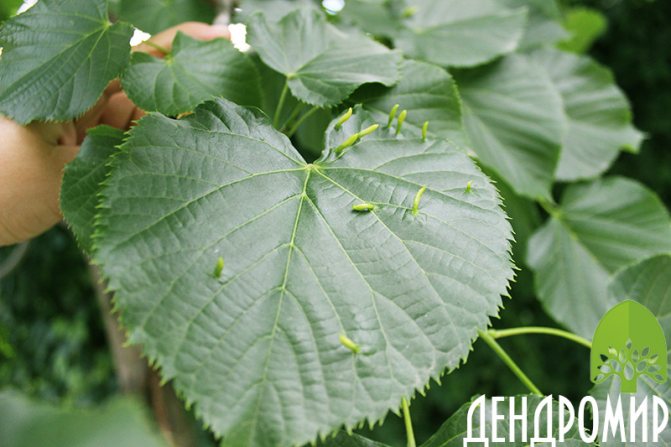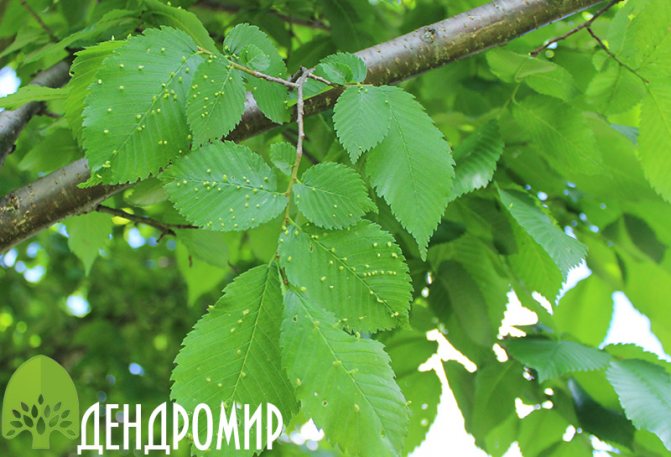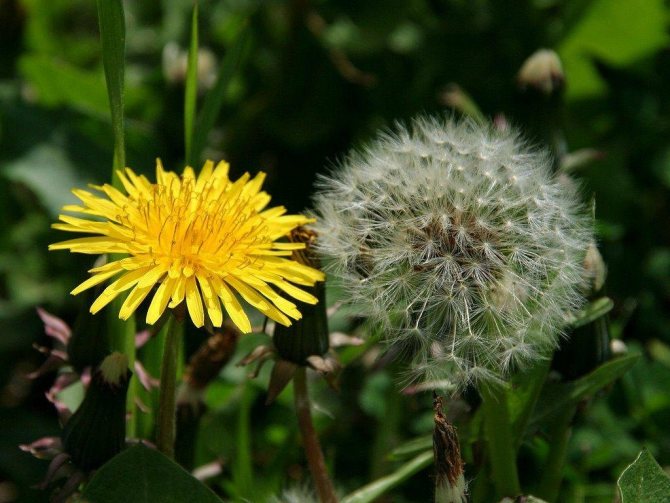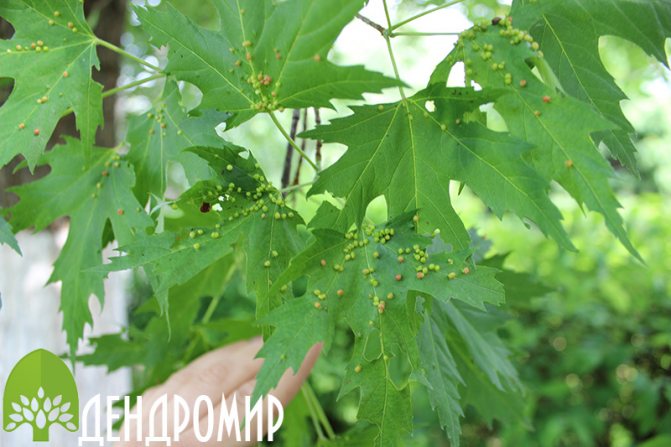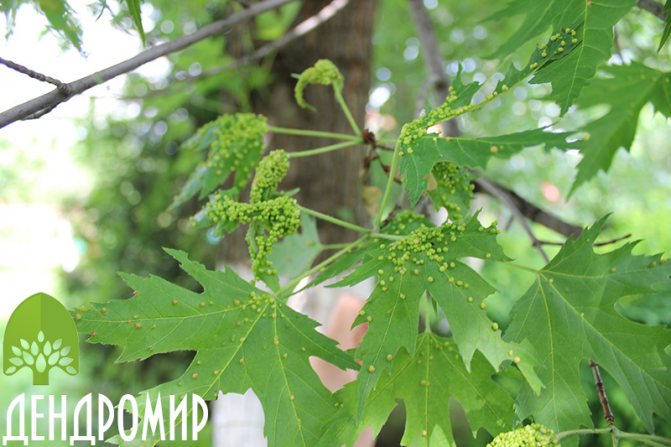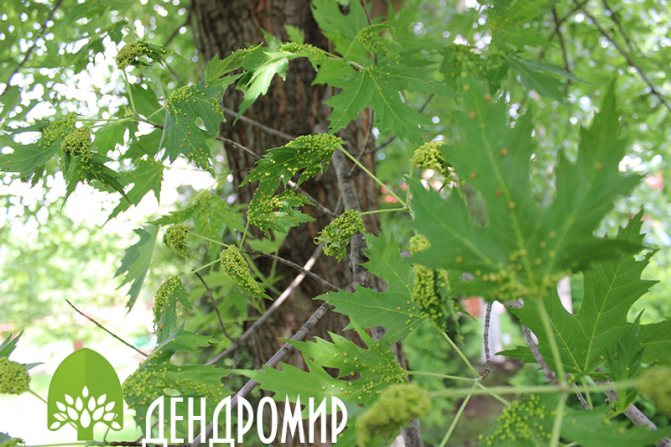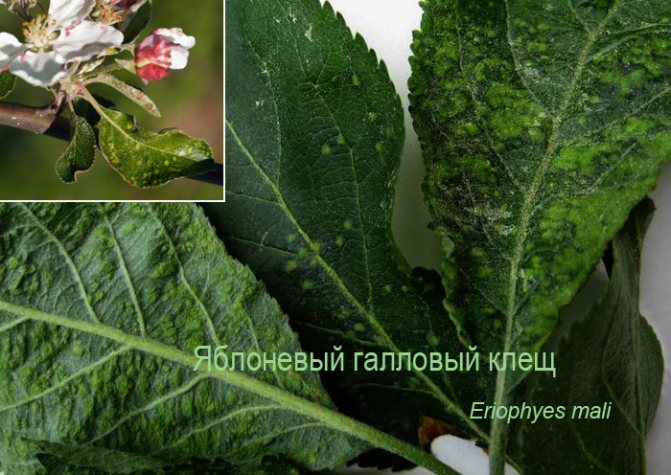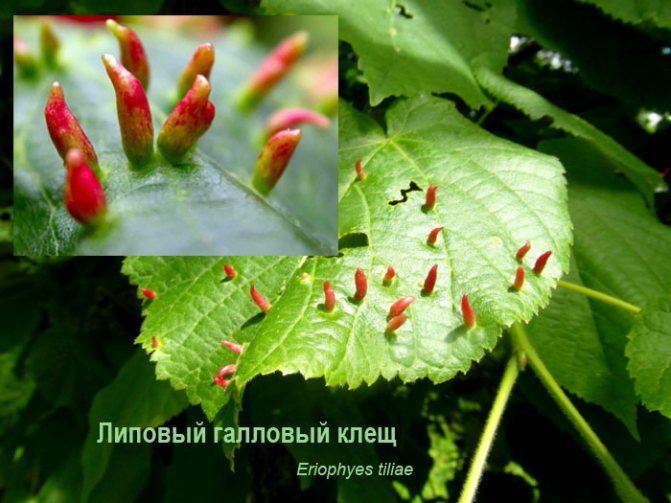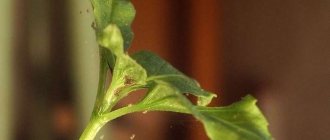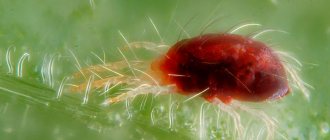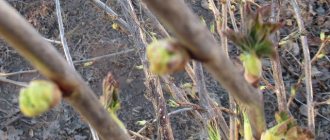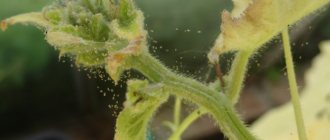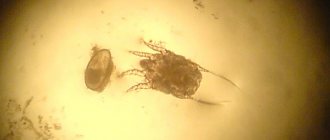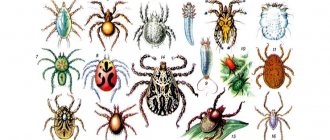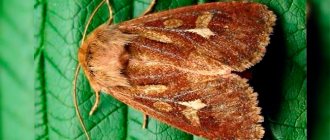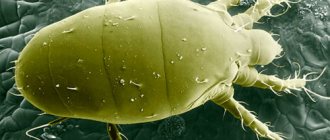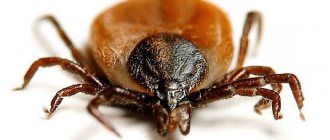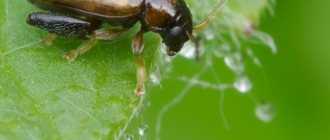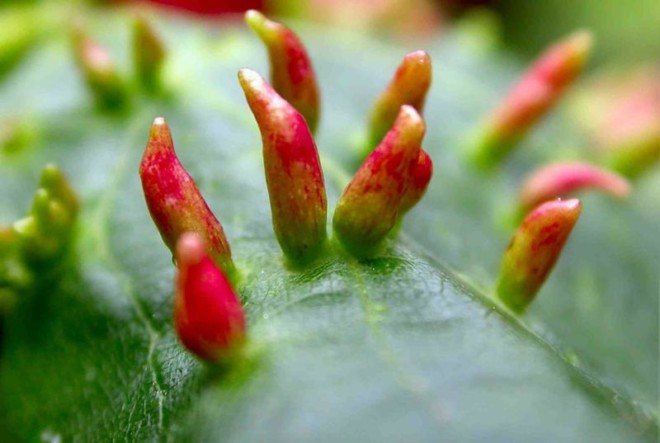
Gall mite is a dangerous pest on a pear. What is the danger of a small parasite for a pear tree. What effective methods of struggle exist. The use of agrotechnical methods. Chemical treatment. The use of folk methods. Tips and tricks.
Everyone knows about ticks that attack people and animals, while carrying the danger of contracting infectious diseases. But there are mites that harm humans by parasitizing plants, while they can cause significant damage to garden crops. Such parasites include the gall mite, which we will consider in more detail below.
How to recognize a gall mite
Before embarking on the fight against a pest, it is necessary to find out the signs of its appearance and determine whether it is exactly it. The pear gall mite, like the parasite on the plum, appears most clearly at the beginning of summer, when the leaves have already blossomed. The parasite itself has the following appearance:
- the size of the tick is very small, only 0.18 mm;
- the color of the calf is white, by autumn it becomes pinkish or light brown;
- two pairs of legs allow the pest to travel in the desired direction without problems.
It will not be possible to look at it with the naked eye, the features of the appearance are visible only in the photo of the gall mite. Harmful activity is distinguished by the characteristic darkening of the leaves, the affected parts of the tree acquire a brown tint. The gall mountain ash mite is recognized by the sharp yellowing of the leaves, then dark spots appear.
Pests of pears are not afraid of low temperatures, they spend the winter in the buds of boles, which earned the name kidney mite.
Up to 150 parasites can hibernate in one bud, each of which will lay 4-6 eggs here.
Larvae develop in winter. In the spring, when the development of the leaves begins, each of them will already have a "lodger" who feeds on juices and forms galls. On pear leaves, tick infestation manifests itself as follows:
- yellow-brown or black small dots;
- small bumps that create the effect of expanding the sheet plate.
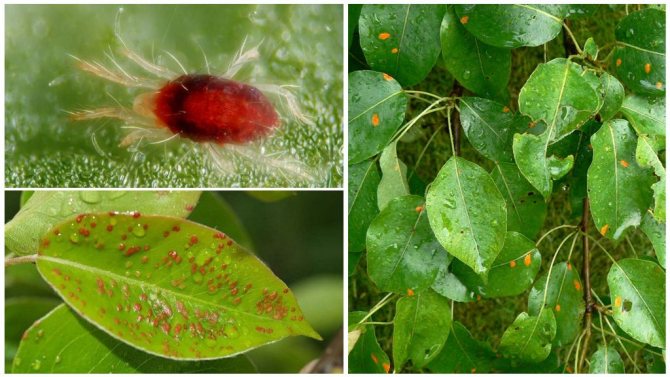

Gall mite on a pear
Clumping swellings form, as it were, a tumor on the leaves, sometimes it can burst, this indicates that the ticks have little space and they choose a new object for their vital activity.
Description and appearance
In fact, gall mites are not a separate parasite, but a whole family of about 3,600 species. It should also be said that today this entomological branch of gall mites is the least studied. This family, called Eriophyidae, is a parasite of mites on plants, galls and tissue damage.
These are parasites of very small sizes, microscopic organisms. They resemble a worm in appearance, only much smaller in size. The body color can be yellow, pink and even purple. The insect has 4 legs, hind legs are reduced, limbs are located near the head.
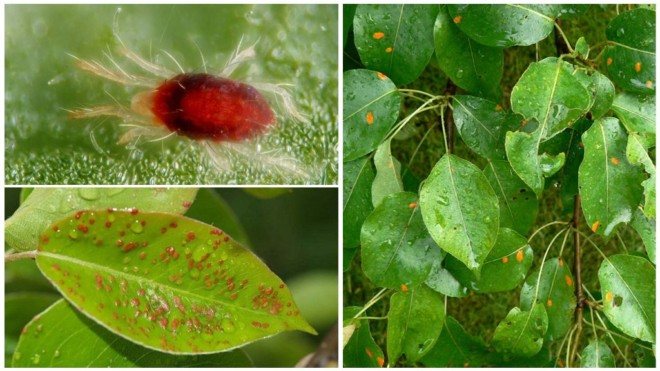

Infection of new territories with the parasite, most often, is carried out due to the wind. Namely, the wind easily picks up and transfers parasites to new, uninfected areas. Also, the wind carries the foliage on which the tick parasitizes. This species is capable of causing great damage to crops.But it's also worth knowing that some types of gall mites can be beneficial because they can be used to control invasive plants and weeds.
These microscopic parasites are found all over the world. If we talk about our country, then we have a widespread pear parasite, which most often parasitizes not only on pear trees, but also on hawthorn and quince. For the winter period, it hides under the scales of the buds, where it remains until spring. When the average air temperature reaches 10 ° C, it leaves the shelter and enters the active stage.
Gall mites harm
Pests such as gall and spider mites negatively affect the growth and development of garden plants. The parasites that have settled on boles suck the sap from the tree, thereby depriving the plant of its strength. The consequence of such a defeat will be:
- lower yields, and the fruits will become smaller;
- leaves will develop poorly;
- branches may dry out.
With a large accumulation of ticks, the bole may die altogether. There is a cure for garden plants for this scourge. Gall mite control is carried out not only in summer, treatment should be carried out regularly, starting in the spring months.
The gall mite can easily settle on an apple, pear, sea buckthorn, currant, as well as maple.
Antiparasitic pear treatment
To suppress the population of pear gall mite, chemicals such as:
- Aktofit is a neurotoxin of biological origin that affects the nervous system of the tick when ingested. When surfactants are added to the working solution, the effectiveness of the drug increases significantly. Compatible with growth regulators, pyrethroids, phosphorus-containing insecticides and fungicides, except for alkaline agents.
- Aktara - causes paralysis and subsequent death of the tick. The protective effect of the drug lasts for 4 weeks.
- Actellik is an effective agent designed to combat numerous pests of cultivated plants. It successfully resists gall mites. Compatible with other drugs, with the exception of Bordeaux liquid. The protective effect of Actellik lasts from 3 to 15 days.
- Agravertine is a powerful insectoacaricide that paralyzes the tick, thereby causing its death. After 6-10 hours after using the drug, the pest loses its ability to eat and dies after 2-3 days.
- Vertimek - the active substance of the drug abamectin penetrates into leaf tissue and destroys mites through the intestines or through direct contact.
- Karate Zeon - the active ingredient of the drug lambda-cyhalothrin begins to "work" after the working solution has completely dried on the leaves or directly on the parasites. The death of the latter occurs within 0.5-3 hours after spraying the crown.
- Kleschevit is a contact-intestinal insectoacaricide that causes paralysis of the tick. 6-8 hours after treatment, the parasite stops feeding and dies on 3-4 days.
- Fitoverm is an insectoacaricide of contact-intestinal action, causing the death of the parasite 2-3 days after treatment.
It is recommended to treat pears with chemical preparations in the morning or in the evening in clear, calm weather. Before starting work, you should check the weather forecast: if precipitation is expected in the next 10 days, the procedure should be postponed.
Advice: since the gall mite quickly acquires immunity to the active substance of a particular agent, it is advisable to alternate or mix the preparations (provided they are compatible). And do not forget about safety precautions: prepare the working solution with gloves, and wear glasses and a respirator while spraying. After completing the work, be sure to wash your hands with soap and sterilize the tools.
From folk remedies in the fight against gall pear mite, the following have proven themselves well:
- Infusion of potato tops - 1 kg of fresh leaves or shoots (or 0.5 kg of dry raw materials) is crushed and poured into 10 liters of warm water.After an hour and a half, add 1 tbsp to the future infusion. spoon of soap shavings. After a day, the liquid is mixed well and used for spraying plantings.
- Dandelion infusion - 1 kg of fresh grass is poured into 3 liters of heated water and left in a warm place for 72 hours. Before use, add 4 tbsp to the infusion. spoons of liquid soap or dishwashing detergent.
- Calendula decoction - 100 g of dried flowers are poured over 1 liter of water, brought to a boil over medium heat, covered with a lid and insisted in a warm place for 5 days. Before use, the solution is diluted with clean irrigation water in a ratio of 1/1.
Note! Means against ticks, prepared according to folk recipes, should be used in combination with industrial insectoacaricides, but in no case instead of them. Decoctions and infusions with a tick will not cope without a chemical component.
How to deal with gall mites
You can get rid of an unwanted garden dweller in several ways, each of which will have a good effect. Processing a pear or other fruit plant is carried out both with chemicals and folk remedies, the effectiveness of which is almost the same.
Agrotechnical control options
These methods are recognized as the most effective, their use will 100% get rid of parasites on the fruit representatives of the personal plot and on the bird cherry.
The fight is carried out like this:
- the introduction of mineral fertilizers in the spring and before winter will make the foliage of trees less tasty for parasites, the increased osmotic pressure in the juice will make it difficult for them to feed;
- it is necessary to regularly cleanse skeletal branches and trunk from old bark, they do this at the very beginning of spring and autumn;
- fallen leaves and fruits must be removed from the area around the stamp;
- regularly prune the crown, remove dry and old branches in time.
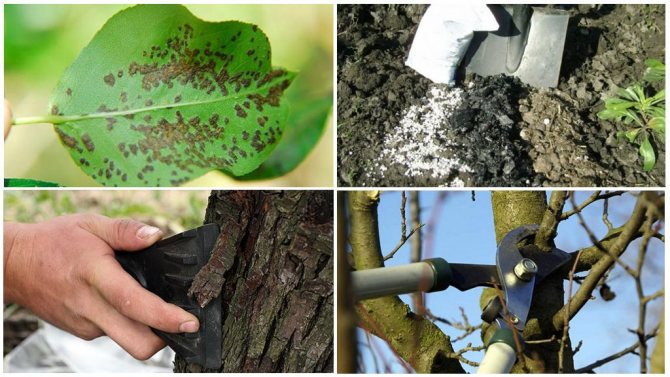

Gall mite control
It will be correct to completely remove the weeds from the site, thus depriving the mites of places for reproduction and habitation.
Foliage and branches removed from infected boles must be burned; this must be done immediately after removal from the tree.
Chemicals
Linden gall mite is very afraid of acaricides, these means of control allow you to get rid of pests in a shorter time, thereby allowing the trunk to recover and give a good harvest. It is best to treat stems with parasites with known drugs:
- Decis, which can be bought for 39 rubles. per package with 1 g of substance;
- Inta-vir acts in a similar way, its price starts from 40 rubles;
- Kleschevite;
- Anti-mite;
- Fufanon from 35 rubles. for the same amount of dry powder.
Fruit trees are treated regularly with these agents, the total duration of treatment is two months, and the treatment is carried out twice a week. The effectiveness of each of the drugs is quite high, and it is better to fight in the spring.
When choosing a new stem for the garden, it is necessary to carefully examine the selected tree for the presence of pests. It should be understood that one copy can easily infect the entire garden in a fairly short period.
You can use the selected tool for prophylaxis, only the purchased stem is treated with a substance diluted according to the instructions before disembarkation.
Traditional methods
It is possible to eliminate the linden felt mite from the site without harmful chemicals. Experienced gardeners recommend using traditional methods, the benefits of which will be many times greater.
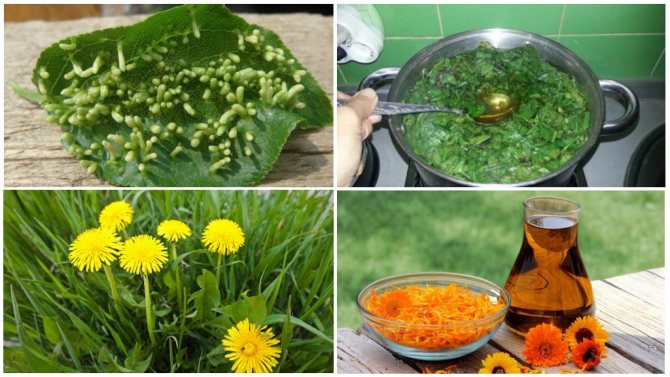

Folk ways to combat gall mite
You can fight parasites on the site using several effective recipes:
- Potato infusion will help to cope with the problem quickly and efficiently, for its preparation you will need a kilo of fresh tops or exactly half in dry form.The crushed stems are poured with a bucket of warm water and kept for 4 hours. Then add a tablespoon of laundry soap and stir well until the additive is completely dissolved. Apply the solution throughout the day from the moment of preparation.
- An infusion of marigold flowers is no less effective, 100 g of fresh or dry matter is poured with a liter of boiling water and boiled for 5-7 minutes. Insist 5 days, filter, add the same amount of pure boiled water.
- An ordinary dandelion will help to exterminate ticks on the site, a kilo of its leaves are poured with 3 liters of warm water, kept in a dark place for three days, filtered, and a tablespoon of crushed laundry soap is added.
Using folk remedies, they strictly adhere to the recipe so as not to harm the plants.
The gall pear mite can cause a lot of damage to the garden, so you need to fight it immediately after detection.
Summing up
As you can see, an insect such as a gall mite can cause significant harm. They do not need any special conditions for infecting a tree, they multiply quickly and in a short time a large colony of pests lives on the pear. When they multiply, they move to new trees, which greatly complicates the situation.
It is worth remembering that there are factors that increase the risk of infection. Agrotechnical recommendations are necessary, use a minimum of phosphorus fertilizers and monitor the condition of trees. In difficult situations, you will need to use chemicals, but remember that their effectiveness and safety depends on specific periods.
It will be effective to use control measures in a complex, combine agricultural methods and folk remedies, and after harvesting, chemical preparations can be used.
Description of the pest
The gall mite that lives on the pear belongs to the sucking insect species. It cannot be seen with the naked eye, since the body of the pest reaches a maximum size of 0.3 mm. With the help of a sharp proboscis, he perforates a leaf and sucks out cell juices from it. The tick can live everywhere where pears are grown.
In winter, mite larvae hide under the scales of deciduous buds, and with the onset of heat they suck the juice out of them, as a result of which the bud dies. In the same period, the females lay eggs, and the larvae that have grown from them continue to suck the sap from the tree. 3-5 new generations of ticks grow in one season.
Who is it?
Gall mite is a microscopic parasite, ranging in size from 0.3–1 mm, that infects plants and causes them great damage. The insect gives preference to plums, pears, apples, currants and viburnum, but it can also parasitize on other types of green spaces (mountain ash, bird cherry, etc.).
The main harm from parasites is damage to the leaf plate. This part of the plant is unable to function normally and loses the ability to photosynthesize. As a result, the tree or bush weakens, weakened buds are laid, the growth of the plant slows down significantly, it ceases to bear fruit.
Gall spider mite is a spindle-shaped insect, the color of which varies from white to brown. It is found everywhere. The size of the parasites usually does not exceed 3 mm. Infected leaves are easy to spot, they begin to change color and curl, and spherical outgrowths appear on their surface. This type of mite is spread by the wind and other larger insects.
Reasons for the appearance
Gall mite spreads under the influence of human factors, with the help of insects and birds, as well as wind, which contributes to the appearance of pest larvae. A thickened crown, a long absence of sanitary pruning, as well as an excess of fertilizers containing phosphorus in the soil can provoke its occurrence on the pear.
Some stimulants used in horticulture can increase the number of gall mites.In addition, insecticides, actively used recently, destroy the natural enemies of a dangerous pest. Diseases also greatly weaken the pear, making it available for the reproduction of pathogenic organisms.
Possible causes of plant infection
There are several factors that provoke damage to leaf tissue by a gall mite:
- sick trees of young age are more susceptible not only to parasites, but also to infections;
- warm weather with moderate rainfall (heat and constant downpours negatively affect insect activity);
- good fertilized soil is a favorable condition not only for plants, but also for the reproduction of gall mites. However, along with them, the population of the enemies of parasites increases: spiders, predatory beetles, etc.
With their rapid reproduction, insects do not just harm, but destroy the plant completely.
Gall mite control measures
Prevention of the appearance of a gall mite in the garden consists in observing simple agricultural measures. However, if the pest is already assimilating on your favorite varieties of pears, you must act urgently.
Chemical treatment
Chemical methods of gall mite control bring the fastest result. In addition, they are recognized as the most effective and efficient.
Apollo
Apollo is a contact pesticide. It is able to completely destroy pests without harming the beneficial fauna of the garden. A feature of the drug is that after processing, not only adults die, but also young animals, as well as eggs laid by females. Processing is carried out in accordance with the instructions attached to the tool.
"Karate"
The Karate drug destroys not only female gall mites, but also their eggs. It is not recommended to use it if there is an apiary nearby. The active ingredient simultaneously destroys many other garden pests and their larvae.
"Fufanon"
Pesticidal agent for contact intestinal exposure. It is based on an organophosphorus compound. In addition to the gall mite, it helps to get rid of other pathogenic microorganisms. Recommended for use if insects have acquired immunity to pyrethroids.
Biological pesticides
Supporters of organic farming, when fighting gall mite on pears, often prefer biological pesticides, considering them harmless to the environment.
"Vertimek"
This drug contains a biological pesticide in its composition, obtained by processing the waste products of fungi. Refers to the means of contact intestinal exposure. Use "Vertimek" if the gall mite living on the pear has shown resistance to other acaricides. The active substance does not act through cell membranes, therefore it does not have the property to accumulate in fruits. The effectiveness of the drug improves with increasing ambient temperature.
Fitoverm
When a gall mite appears on trees, effective control of it by spraying with pesticides is carried out before the budding begins or immediately after flowering ends. During the first spraying, the female pest is destroyed, which spent the winter in the buds of the tree. Fitoverm is well suited for this purpose. As a result of its influence, it is possible to avoid the wave of mass reproduction of insects in the spring.
Rules for the preparation of folk remedies
Folk remedies based on natural ingredients help to fight the invasion of gall mites on pears. Dandelion infusion has proven itself excellently, which is prepared as follows. Take 1 kg of fresh dandelion leaves, pour 3 liters of water and leave to infuse in a dark place for 3 days. The resulting infusion is filtered, a little liquid soap is added and a pear is sprayed with it.
To get rid of the gall mite, an infusion of marigold herb is prepared.Take 100 grams of flowers and boil them in 1 liter of water for 5 minutes, after which they insist in a dark room for 5 days. After that, the infusion is filtered, diluted with water in a ratio of 1: 1 and the pear is sprayed.
An excellent result in the fight against gall mites is shown by infusion of potato tops. It is prepared from 1 kg of fresh or 0.5 kg of dried chopped tops, which is poured with 10 liters of warm water and allowed to brew for 4 hours, after which it is filtered, a little liquid soap is added and the pear is processed.
You can use the prepared infusion only during the day, after which it becomes unusable.
Processing pears against gall mites is carried out in the morning or evening hours, as well as in dry cloudy weather. Under the rays of the scorching sun, droplets of liquid can provoke burns on the leaves. In addition, some active ingredients lose their effectiveness under the scorching sun.
What are Gauls and how are they formed?
Gauls are growths on plants that are unnatural and abnormal. Their formation is carried out by microorganisms such as ticks, bacteria, nematodes, viruses, etc. They consist of plant cells, but in this case they are not natural formations, but refer to harmful abnormal formations, like other cells.
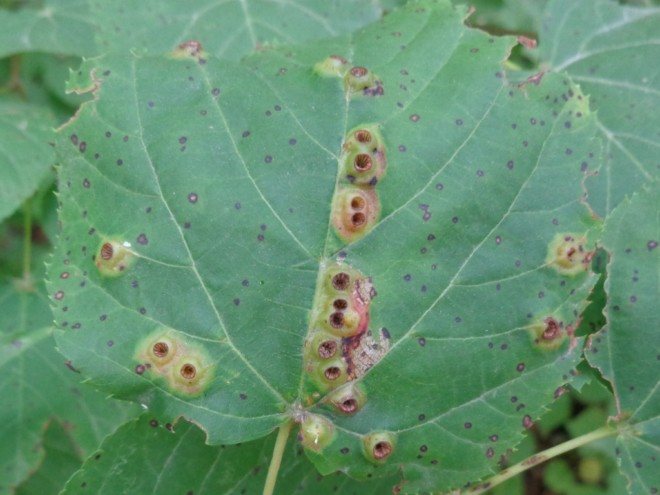

Microorganisms form galls in order to maintain the population, since they serve as a shelter from the external environment. There the pests grow their offspring and thereby ensure the maintenance of the colony and the growth of the population. By themselves, Gauls do not pose a great danger to the plant.
There are several types of galls, which are distinguished by the place of formation, these include:
- Leafy. This is the most common type, growths are formed on the outside or inside of the leaflet, you can also see them on the petioles. Externally, the growths can differ significantly. It can be a gall in the form of a blister, a fluffy felt formation, a curl or a nipple-shaped appendage.


- Stem, branch. Placed on the branches and stems of plants. They can appear as a small build-up in the form of a swelling or be quite large.
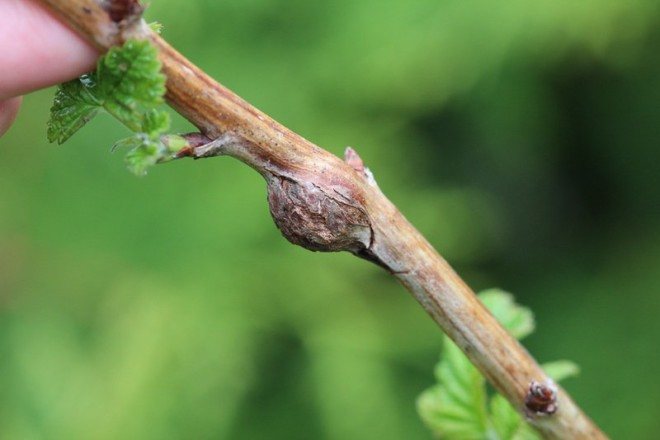

- Floral. In this case, the deformation of the bud-shaped structure of the flower occurs. They can have completely different sizes and change shapes.


Most often there are gall pests that parasitize plant leaves, but there are also those that infect flowers and stems.
Prophylaxis
Preventive measures aimed at combating gall mites on pears are aimed at not creating favorable conditions for the reproduction of the pest. It is necessary to correctly and accurately calculate the dosage of the applied dressings, especially those containing phosphorus.
It is imperative to carry out sanitary pruning of trees, remove dead bark, with the onset of autumn, remove the leaves and dig up the soil in the peri-stem circle of the pear. Timely whitewashing of the trunks with a solution of lime also prevents gall mites from appearing in the garden.
Growing weeds should be either completely removed from the site or cut. In the latter case, the roots remaining in the ground will replenish the supply of nutrients. Treatment with chemical and biological agents, as well as folk remedies designed to destroy gall mites, is also recommended for prophylactic purposes. Its frequency is once a month.
A good result in the prevention of the appearance of pests on pears is shown by the use of trapping belts, for the manufacture of which burlap or corrugated paper is used.
Preventive actions
Of course, it is always easier to prevent a problem than to deal with a large number of pear mites.
Simple preventive actions that minimize the chance of infection include:
- Be sure to control the process of feeding the trees, namely, observe the correct proportions and dosages. The fact is that an excess of phosphorus contributes to the reproduction of this pest, so its use should be carried out in a minimum amount.
- Do not place prophylactic treatments that use chemicals. The main thing is to do it on time, then do not cause harm to trees and fruits. Particular attention should be paid to processing when it is known about the infection in neighboring areas, territories.
- Agrotechnical methods that are aimed at caring for the pear tree are very useful and effective. Pay attention to cleaning the area from old leaves and weeds, clean the tree from dead bark and old branches, whitewash. These are very simple steps, but the most effective.
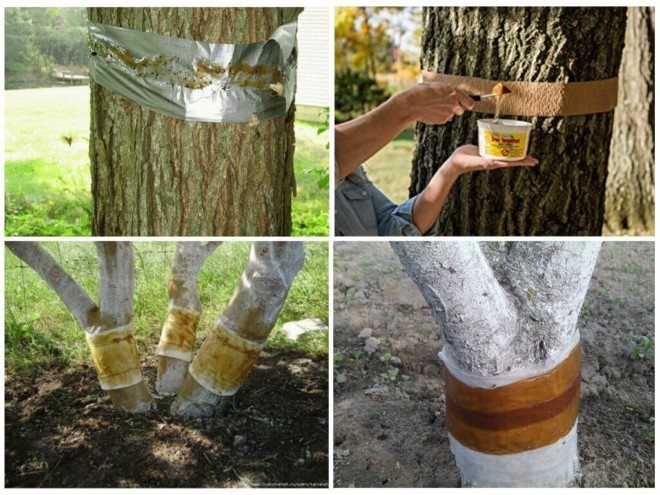

Trapping belts made of burlap or corrugated paper are quite effective and show good results. They help protect fruit trees from most types of pests.
How to deal with pear gall mites
Pear gall mite is one of the most dangerous and difficult to remove pests. They are common in all regions where pears are grown. In addition to pears, they damage other crops from the Rozanov family: quince, apple, mountain ash and cotoneaster. Gall mites negatively affect the development of the tree, as well as its fruitfulness.
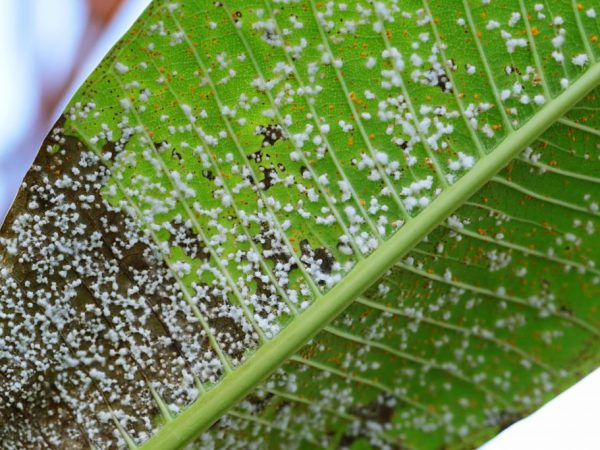

How to deal with pear gall mites
Signs of a tick on pear leaves
The buds affected by the gall mite are clearly visible in spring. They are much larger than healthy ones, but are about 2 weeks late in development. If some of the leaf or flower buds have burst, and some, of a larger size, are not going to open, there is reason to suspect that a gall mite has wintered there. Especially carefully you need to inspect the lower and middle part of the crown in the immediate vicinity of the trunk.
Comment! Flower and leaf buds open at different times, they are easy to distinguish from each other in shape.
Having got out of the buds, the females begin to feed on young leaves. They make pinhead-sized punctures in them and lay their eggs.
- First, light green plaques up to 3 mm in diameter are formed in the damaged areas, which are located on the underside of the pear leaf along the central vein.


- The color of the galls gradually changes to dark brown; they cover a large area.
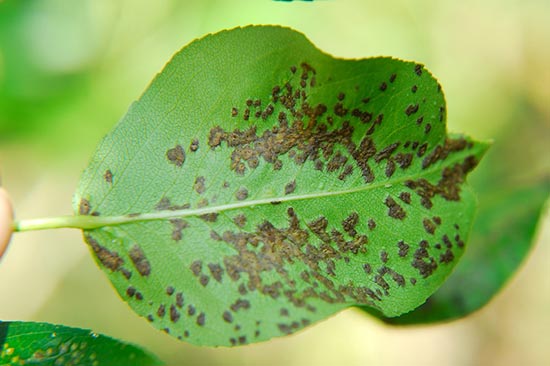

- Brown raised plaques turn black over time. If nothing is done, they merge and cover the entire surface of the ugly twisted leaf, and it falls off.
The nymphs hatched from the eggs of pests in the galls feed on leaves, turn into adults, and soon the next generation of insects appears.
Reasons for the appearance
The main danger of these beetles is that they independently move from one tree to another. Their appearance and reproduction is provoked by the following factors:
- a very large amount of phosphate fertilizers;
- irregular pruning of the crown;
- the introduction of an excessive amount of stimulating drugs for trees.
Sometimes drugs that are used to control other pests do not pose a danger to the pear gall mite. They only destroy its direct enemies - dragonflies, ground beetles, etc.
Signs
Due to the fact that these pests are very small, they are difficult to recognize. The pear gall mite resembles white or light pink worms with four legs that are closer to the head and help them move.
First, small wavy blisters (galls) form on the leaves of pears, ranging in size from 0.18 to 3 mm. Under them there may be adult worms or previously laid eggs of the female. At first, these bubbles merge with the color of the leaves, then they darken and turn black. As a result, the parasites dry out the leaves very much and they fall off.
Beetles can also hide under the bark of a tree, especially in winter. They multiply there and suck out the cell sap from the buds of the tree.This causes the kidneys to become very small or not open at all.
What harm does a tick do
The main diet of this pest is plant sap and leaf cells. When the juice is sucked out, a violation of the water balance occurs, as a result, photosynthesis decreases. This leads to the fact that the leaves are greatly weakened, the plant does not develop correctly, the number of fruits decreases, and the fruits grow much smaller.
If it is impossible to consider the pest itself, due to its small size, then the affected areas on the leaves are very clearly visible. It is on the leaves that this mite forms galls, they are very similar to swollen areas. For an insect, galls are a shelter, it is in them that females lay eggs.


It should also be said that pests multiply very quickly and several new generations may appear in one season. This means that a large number of new sites are required for the formation of galls, where they can parasitize. Due to their rapid reproduction, and also due to the fact that these mites are perfectly adaptable to new conditions, large colonies can appear in a short period of time, which can cause serious damage to gardens and agricultural land. Insecticides are used to control parasites.
Ways to fight
The means of combating pear mites are in the correct and timely care of the tree. If damaged leaves are seen, they must be removed immediately and burned. Branches that are heavily infested should also be pruned.
There are also more radical measures to combat pear mites - chemical treatment and folk methods. These spraying methods should be done in the morning or evening. The best weather is dry, sunny, but the procedure can be carried out even in cloudy weather. Because the sun reduces the effectiveness of the fight against parasites and droplets of solutions burn the leaves.


Chemicals
This method is used more often in the spring, when the gall mite has been on the pear all winter. Before opening the leaves, the pear is treated with Inta Vir. You need 1 tablet for 10 liters of water.
Also, such drugs are used:
- "Akreks". It is a powerful chemical. You can use it against these beetles only 2 times a year, 20 days before harvest.
- "Nitrafen". It is a dark brown complex effect paste that dissolves perfectly in water. It is applied by drip irrigation method.
- Vermitic. A chemical that affects the multiplication of various pests. Advantage - resistant to rain washout.
Processing should be carried out no more than 1 time in 2 weeks. Don't forget about safety measures. All actions must be performed with gloves, a mask on the face and the most closed clothing. It is imperative to change the preparations for processing wood so that the parasite does not develop immunity to them.
Pest injection has also recently become popular. The agent enters the sap flow and causes irritation of the mucous membrane in pests. This method is distinguished by the effectiveness of delivering drugs to different parts of the tree.
Traditional methods
Dandelion infusion is a very good remedy. You need to take 1kg of fresh dandelion leaves and pour 3 liters of water over them. Leave to infuse for 3 days. Before processing the pear, add 100 ml of liquid soap to the strained solution.
You can use potato infusion. You need to take 1 kg of fresh tops, or 500 g dry. Grind it and pour 10 liters of water. You need to insist this solution for 4 hours, then strain. At the end, add 1 tbsp. l. soap and use this product within 24 hours.
Another irreplaceable remedy is an infusion of marigolds. Cooking method:
- You will need 100 g of flowers.
- Boil them with 1 liter of water.
- Insist the remedy for 5 days, then add another 1 liter to it. water.
- You can start using it.
Mites that harm ornamental and fruit plants
This article will focus on dangerous pests of ornamental and fruit plants, namely mites. Herbivorous mites are very small, hardly noticeable and barely distinguishable with the naked eye, and some individuals can hardly be seen under a magnifying glass. It is almost impossible to identify the species of these ticks in the field. The nature of the damage caused by ticks is of great importance for understanding who is hurting and how to deal with it. These pests are essentially not insects, and therefore, control of them with conventional drugs is ineffective. Ticks are classified as arachnids (Arachnida). Basically, ornamental plants are harmed by representatives of two orders of mites (although the taxonomy of these taxa is constantly changing). Acariform ticks (Acariformes), among which the greatest damage to plants is caused by ticks from the superfamily of tetranychoidea ticks (Tetranychoidea). These include spider mites (Tetranychidae) and flat mites (Tenuipalpidae). Very peculiar mites from the order Trombidiformes of the superfamily of four-legged, or gall mites (Eriophyidae). Spider mites (Tetranychidae) Small: length of females - 0.4-0.6 mm, males - from 0.3 to 0.45 mm. From fertilized eggs, females appear, and from unfertilized ones, males. Ticks feed by sucking juices from leaves and young shoots. The upper side of the affected leaves is covered with yellowish spots and dots, and if you look at the leaves in the light, you can see punctures on the lower side. A characteristic sign of the presence of this mite is the appearance of a thin white web along the edge of the lower side of the leaf, and in conifers - between the needles. A sign of mite infestation is also the presence of dandruff-like grayish molar skins on the back of the leaves. Mites overwinter in the bark of shoots and branches of garden plants, in the crevices of greenhouses, in fallen leaves, in weeds.
| Common spider mite (Tetranychus urticae) Widespread species. Especially dangerous for young plants. The body is 0.2-0.5 mm long, greenish-yellow, with dark spots on the sides, has four pairs of legs. Overwintering females are orange-red. Larvae are smaller, have three pairs of legs. The eggs are round, translucent, greenish in color. Both adult mites and larvae, which settle on the underside of leaves, are harmful. Damaged leaves are first covered with light dots, then become marbled, covered with a cobweb, turn yellow and fall off. The development of mites is promoted by high temperatures and dry air. At a temperature of 29-32 ° C, development lasts 8-10 days. During the warm season, the spider mite gives 8-12 generations. At high air humidity, the rate of reproduction decreases. |
| Boxwood mite (Eurytetranychus buxi) Damages boxwood. The female is small, up to 0.45 mm, greenish-brown in color. Eggs are round, orange-yellow, 0.12-0.16 mm in size. The larva is light yellow, immediately after birth with three pairs of legs, about 0.2 mm; nymphs are green, with four pairs of legs, 0.3-0.4 mm. Eggs laid on the underside of the leaf overwinter in groups. The hatching of the larvae coincides with the beginning of the budding of the boxwood. Development takes place quickly, in the southern regions, for example, in the Crimea, it can give 9-10 generations per year. The female lives for about 30 days and lays up to 50 eggs. It causes great harm to spruce trees, especially the Canadian and its ‘Konica’ form, as well as western thuja, juniper, and biota. |
| Spruce spider mite (Oligonychus ununguis) Symptoms of the lesion are a thin, sparse cobweb, entangling the needles, in which females lay eggs. In places of sucking by the female and by the larvae of the tick, the needles are covered with yellowish spots, and later acquire a brownish color and crumble. The mite is oval, up to 0.4 mm in size, grayish-green, with four pairs of legs. The larva develops within 10-20 days. Over the summer, the female gives 3-5 generations. Eggs overwinter on last year's shoots. The greatest damage is done at the end of summer, especially in hot dry years, to poorly watered trees. Control measures: drugs Aktellik, Agravertin, Fitoverm, Neoron. Hormones are good - Apollo and Flumite. These drugs not only kill feeding individuals, but also affect the viability of eggs. |
| Flat pliers (Tenuipalpidae) They are sometimes called false spider mites because they are close relatives. Very small - from 0.1 to 0.4 mm.Under a microscope, the difference between these families is visible: in spider mites, the body is whole, and in flat mites, it is divided by transverse sutures into several parts (front, middle and back). Also, the shape of the body and the color of eggs, which are often reddish-brown, are different. The increased air humidity does not affect the rate of development of flat beetles, while it retards the development of spider mites. They feed, like spider mites, mainly on the underside of the leaves. In many flat beetles, saliva is toxic, and therefore, during feeding, leaf tissue necrosis occurs, which manifests itself in the appearance of brown or gray-brown specks. Squat beetles are also dangerous because they are the main carriers of mosaic and ring spot viruses. Typical representatives of flat mites are fruit flat beef, greenhouse flat beetle, yew and others. |
| Yew flatbed (Pentamerismus taxi) Found wherever yew grows. Damages bark of one-, two-year-old shoots and yew needles. Damaged needles turn yellow and fall off prematurely. The bark of the shoots in the places where the ticks are sucked dies and cracks. The female is 0.3 mm long, orange-red. The egg is orange-red, 0.1 mm long. The larva is bright red, with three pairs of legs, 0.15 mm long. Females hibernate in cracks and folds of the bark and under the kidney scales. Females start laying eggs in the grooves of the shoot bark in late March - early April and live, continuing to lay eggs until July. Development from egg to adult female lasts 50-57 days. It develops in 1-2 generations per year. Control measures: treatment of yew with acaricidal preparations is carried out in the spring, before the start of oviposition by overwintered females. |
| Fruit flattened (Cenopalpus pulcher) Damages a large number of fruit plants. Prefers to settle on plants with a pubescent lower leaf surface. The female is 0.34 mm long, the male is 0.26 mm; the body is elongated, brick-red. Eggs are red, about 0.11 mm, the larva is red. Fertilized females hibernate in cracks in the bark and behind kidney scales. The beginning of the mass release of ticks from wintering sites in spring coincides with the phenophase of the pink bud in the apple tree and lasts 5-8 days. With the development of young leaves, the mites move to their underside and start feeding and laying eggs. The average fertility of females is about 20 eggs. It develops in 1-2 generations per year. The duration of development from egg to adult tick lasts from 40 to 50 days. Control measures: early spring spraying with acaricidal preparations. |
Four-legged ticks (Eriophyoidea)
One of the most extensive groups of plant pests, including more than 4000 species. These are very small mites - 0.1-0.3 mm, but they pose a serious threat to plants, not only sucking out juices, but also causing a change in the shape of cells and organs. So, feeding on a plant, a tick, when piercing the membrane of living cells, secretes saliva, which contains a substance that has a teratogenic effect in many species. As a result, various pathological neoplasms of galls can develop on the plant: felt, plaques, twists, horns. In addition, phytopathogenic bacteria and viruses penetrate plant cells with the saliva of ticks - pathogens of such serious diseases as peach mosaic, currant reversion, wheat striped mosaic and many others. Currently, there are five main types of galls caused by four-legged mites: leaf, stem, crustal, bud, and fruit. For example, various formations appear on the leaves: felt, plaques, twists, horns, vein galls. These formations significantly weaken the plant and reduce their decorative effect. The appearance of the galls can tell which pest caused the disease. It is difficult to fight gall mites, since acaricidal drugs do not have a pronounced systemic effect. Types of mites that form galls and felt
| Hawthorn edge mite (Eriophyes goniothorax) It develops on the common hawthorn, causing the leaf edge to roll upwards. The inner surface of the gall is covered with a thick whitish felt. Gauls darken over time. |
| Pear gall mite (Eriophyes pyri) Affects the leaves of pear, quince, hawthorn, mountain ash, cotoneaster. Forms galls in the form of low flattened swellings. Gauls are first green, then brown. If the tick settles on young fruits, the fruits bend and fall off. |
| Willow three-pointed gall mites (Eriophyes triradiatus) Causes peculiar formations called "witch's brooms". |
| Felt grape mite, grape itch (Eriophyes vitis) A common pest of grapes. It affects leaves, less often young shoots, brushes, buds. |
| Yew kidney mite (Cecidophyopsis psilaspis) Occurs in both vegetative and reproductive buds. The number increases from May to August, the maximum is in June, the lowest is in March and October. The size of the mites is very small, in the kidney there are up to 100 mites. |
| Linden gall mite (Eriophyes tiliae) Forms characteristic, highly elongated galls on the upper side of the leaf blade. |
| Alder felt mite (Eriophyes brevitarsus) Affects alder leaves. Damaged leaves quickly lose their decorative effect and fall off early. |
| Walnut felt mite (Eriophyes erineus) Affects walnut leaves. Gauls have the appearance of large rounded bulges. On the underside, the leaves are covered with a very thick yellowish felt. |
| Nut gallic (warty) tick (Aceria tristriata) Affects walnuts. The development of a mite leads to the appearance of small warts-galls over the entire surface of the leaf. In autumn, it can form clusters in the form of a rusty coating on the buds of a walnut. |
| Rowan felt mite (Eriophyes sorbus) Distribution - Central and Eastern Europe. It parasitizes the common mountain ash (Sorbus aisiparia), causes the formation of irregularly shaped felt. At first, the felt are whitish, later they darken. Severe damage leads to a loss of decorative effect. |
| Plum Gall Mite (Aceria phloeocoptes)
|
| Plum pocket mite (Eriophyes similis) Found in many parts of Europe on plums and thorns. Causes the formation of galls on the leaves of affected plants. Gauls are concentrated along the edge of the leaf blades. |
| Currant kidney mite (Cecidophyopsis ribis) Length - about 0.2 mm, white body, worm-like, with 4 legs. Most often it develops on black currants, less often on gooseberries and red currants. The development of ticks occurs inside the kidneys (in one kidney there can be more than 3 thousand individuals). In the spring, during the period of bud swelling, the female lays up to 40 eggs. The inhabited bud acquires a rounded shape, and in the spring of next year it grows to the size of a pea and looks like a tiny head of cabbage. It can develop in five generations in a year. Ticks settle mainly with plant material and naturally. Control measures: the easiest way is to destroy infected buds and branches, as well as treatment in the spring with acaricidal or insectoacaricidal preparations. |
| Apple gall mite (Eriophyes mali) Widespread throughout Europe. It feeds on an apple tree. Small, flat, light, rounded galls (0.5-3 mm) are formed on leaves, fruits, flowers. Ticks hibernate in the buds. |
Tick control methods To combat ticks, there is a fairly extensive list of drugs. The most common is, of course, Actellic. But since today there are no permitted systemic acaricides, the fight against ticks, especially those that hide them, is difficult. The solution to the problem is somewhat facilitated by the use of drugs with translaminar properties, that is, with the ability to penetrate into plant tissues to a certain depth, but not spread through the vascular system. Abamectin, which has a neurotoxic effect on many ticks and thrips, has a good translaminar effect.A new class of drugs - inhibitors of lipid metabolism LBI - have shown good efficacy against ticks. These are the drugs Envidor, Oberon and Judo. These preparations can also be used to treat indoor plants. As already mentioned, ticks are not insects, and treating them with the usual preparations designed to kill insects - insecticides - will not give an effect.
* All drugs are given for reference only, keep an eye on the availability of these drugs in the official publication "Transfer of pesticides and agrochemicals, allowed until victorious in Ukraine".
Material prepared by an employee of the online store
RETURN TO SECTION
Prophylaxis
In order not to initially start the fight against the tick, you need to choose a healthy seedling. It should be carefully examined for pests. Because an infected tree poses a threat to other horticultural crops.
Pear gall mite may appear due to excessive use of phosphorus to fertilize the pear tree, so you need to carefully calculate the doses of its use - act according to the instructions.
- carry out timely sanitary pruning of tree crowns;
- remove dead bark from a tree trunk;
- in the fall, remove fallen leaves in the garden and burn them;
- dig a trunk circle near a tree;
- weeding weeds or pruning so that its nutrients get to the root of the tree;
- periodically whitewash the trunks with lime.
For prevention purposes, trees can be treated with chemicals once a month. You also need to protect pears from the wind, because it is one of the main carriers of the pear gall mite.
Preventive measures
Preventive measures are important in the fight against gall pear trace:
- regular sanitary pruning of branches;
- timely cleaning of fallen leaves, weeds and other plant debris;
- mechanical processing (digging or loosening) of the soil of the trunk circle;
- spring and autumn crown treatments with chemical insectoacaricides.
The gall pear mite is a serious enemy, but acting according to a predetermined plan, you will surely defeat it and save the pears from inevitable death. Good luck!
{SOURCE}
Description of pear gall mite and signs of plant damage
The gall mite is one of many pests that feed on the sap of fruit trees. Most often pears suffer from it, but it also attacks apple, quince, mountain ash, hawthorn, dogwood. The larvae carry insects, birds, wind.
Larvae and adults overwinter under the scales of leaf buds. When the air warms up to 8–10 ° C in spring, they become active. Pests begin to suck juice from buds and blossoming leaves, females lay eggs. During the season 3-5 new generations of ticks are born.
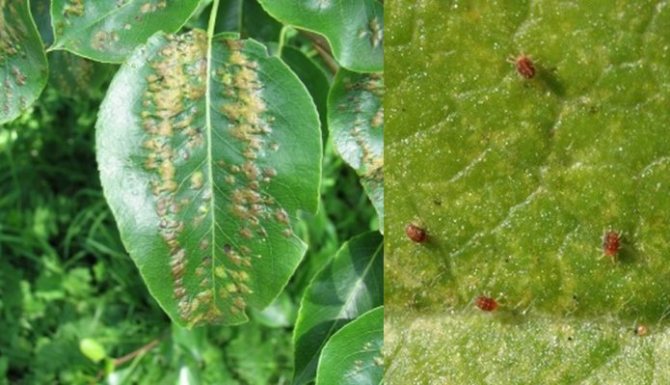

The pear gall mite does not have a short "burst" of activity, during which fruit trees must be protected from it - the risk of infection persists throughout the season, from spring to autumn
The gall mite itself will not kill a tree. But as a result of his attacks, the growth of new shoots is inhibited, leaf and flower buds, buds, and ovaries are destroyed and deteriorated. Affected buds produce deformed leaves that cannot normally perform photosynthesis. The ovaries either do not form at all, or they also turn out to be ugly, quickly crumble. Crop losses can be 90–95%.
How are Gauls formed?
Galls are generated by various living organisms, as a rule, for the laying of eggs and the maturation of larvae. The record holders for the formation of galls are the mites of the same name. The formation of "cancerous tumors" is based on either mechanical damage to the leaf as the tick feeds, or the effect on plant cells of the salivary secretions of the pest, which initiates an increase in the production of normal growth hormones.These plant hormones cause localized cell growth, which can lead to an increase in cell size (hypertrophy) or cell number (hyperplasia). The result is always an abnormal structure, which is called Gauls.
Gall formation usually occurs during the accelerated growth period (late spring) of new leaves, shoots, flowers, and so on. The maturity of plant tissues, as a rule, does not depend on the size and other qualities of galls, but directly depends on the activity of gall mites.
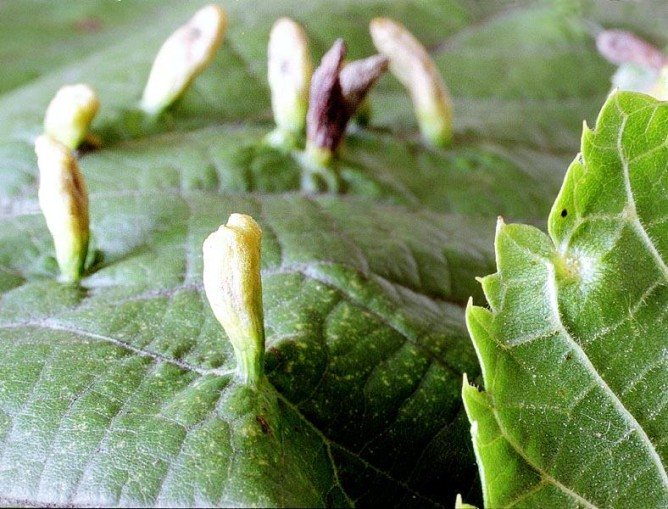

Methods for dealing with pear gall mites
It should be remembered: the gall mite is not an insect, but an arachnid. Therefore, conventional broad-spectrum insecticides are useless in the fight against them.
Early Spring Spray Chemicals
This is the most effective method in the fight against a pest, giving the fastest possible result. But keep in mind that the pest quickly develops immunity to any drugs; after 2-3 treatments, the agent must be changed.
Do not forget about safety measures, use personal protective equipment (goggles, respirator, gloves, hat, tight clothing that completely covers arms and legs). Strictly follow the instructions in the instructions regarding the concentration of the drug in the solution and the frequency of treatments.
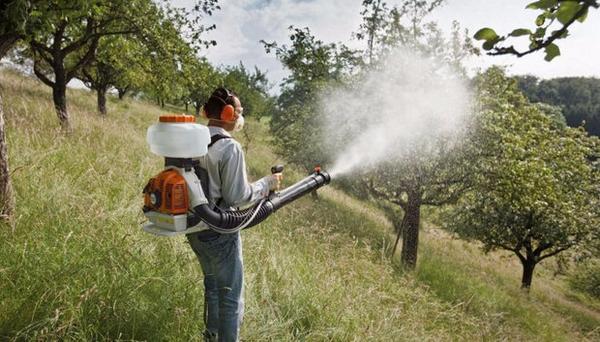

When treating the garden with any chemicals, even if they are positioned by the manufacturer as safe for humans, take care of protecting the skin and mucous membranes
A cloudy, windless day is chosen for the procedure. The algorithm is as follows:
- Prepare a working solution (it cannot be stored).
- Pour the product into a container with a spray bottle.
- Process the tree and the soil underneath as thoroughly as possible, paying particular attention to the buds.
For the prevention of spraying, it is carried out in early spring, while the buds have not yet opened, at the time of the formation of ovaries and in the middle of autumn. To combat gall mites, 3-5 treatments with an interval of at least 10 days are usually sufficient. It is undesirable to process the tree 20-25 days before harvest, unless the drug is safe for human health and the environment.
- Apollo. Contact pesticide based on pyrethroids. Destroys adult gall mites, larvae and eggs without harming the useful fauna.
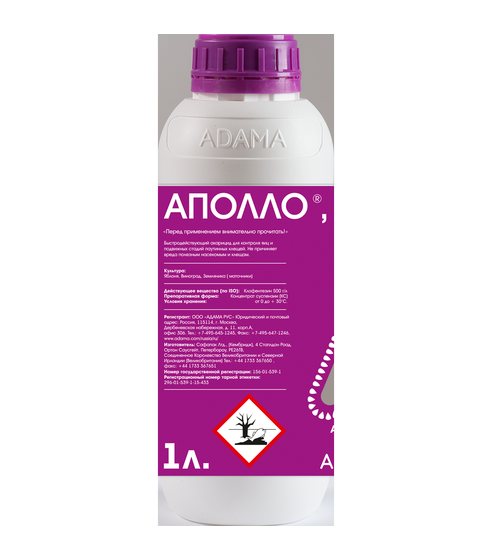

Apollo is a selective acaricide that destroys gall mites, but does not harm beneficial insects
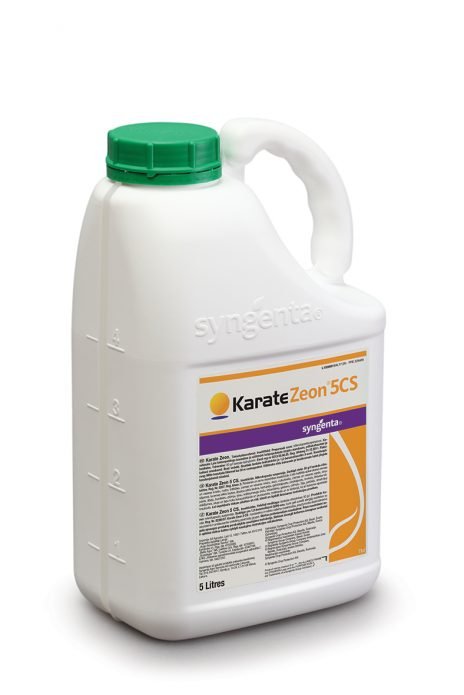

It is undesirable to use the Karate Zeon preparation if there is an apiary somewhere nearby
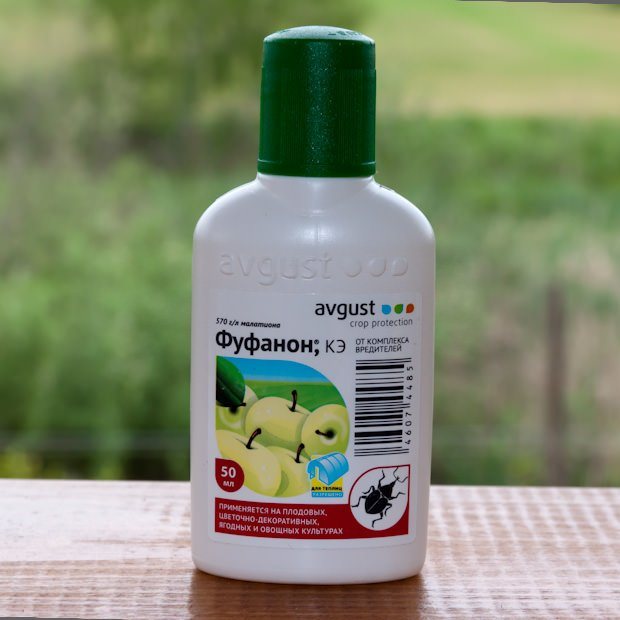

The drug Fufanon helps to simultaneously get rid of many garden pests
A relatively new method of dealing with gall mites is injection. Microdoses of chemicals containing sulfur and phosphorus are injected directly into the sap flow system. The procedure requires professional skills and equipment. They do not do it on their own, inviting specialists from horticultural centers. Injections are carried out at the same frequency as preventive chemical treatments.
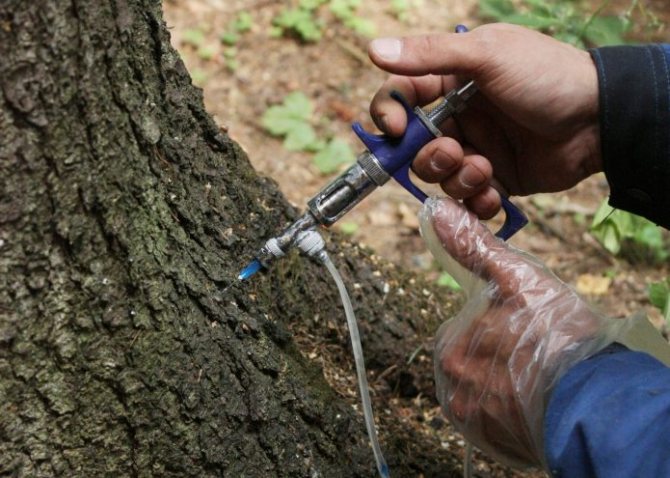

Only a specialist can correctly "prick" a fruit tree
Biological preparations
A significant advantage of such preparations is environmental safety and the ability to carry out processing at any time. They are less effective than chemicals in helping to deal with gall mites if the problem is noticed early:
- Vertimek. Means of intestinal action, the active substance is processed waste products of fungi. The effectiveness of the drug increases in heat. The crop can be harvested as early as 3 days after processing.
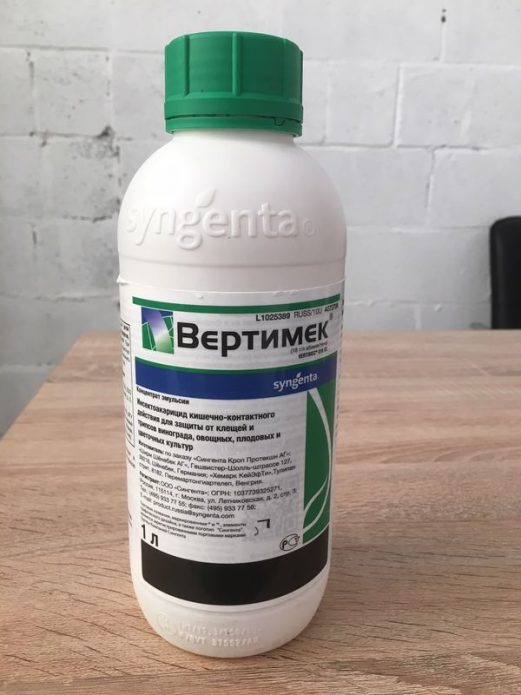

The higher the air temperature after treatment, the more effective the Vertimec preparation.
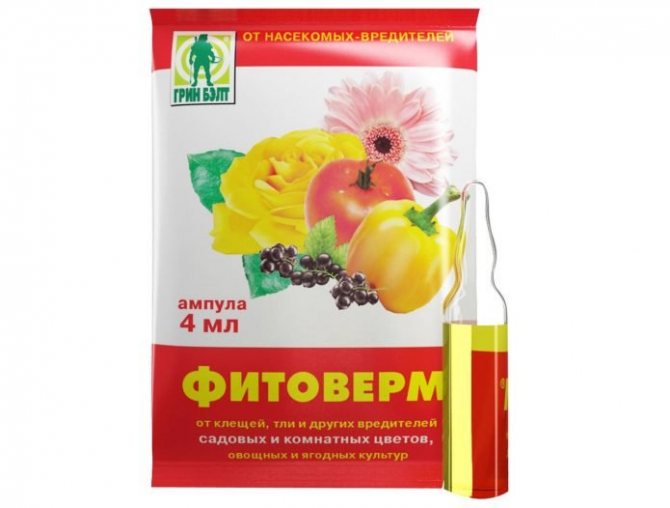

Fitoverm is one of the most popular biological preparations for pest control among gardeners.
Video: instructions for using the drug Fitoverm
Folk remedies for spring and summer treatments
Traditional methods of dealing with a gall mite in case of mass infection are useless.They are practiced mainly by adherents of natural agriculture on absolutely healthy trees. Folk remedies do not give a full guarantee of protection against pests. They work for 10-15 days (or until the first rain). To make the composition better "stick" to the leaves, add small soap chips (15–20 g per 10 l):
- Dandelion infusion - chop 1 kg of fresh leaves, pour 3 liters of warm water, let it brew in a dark place for 3 days. Strain before use.
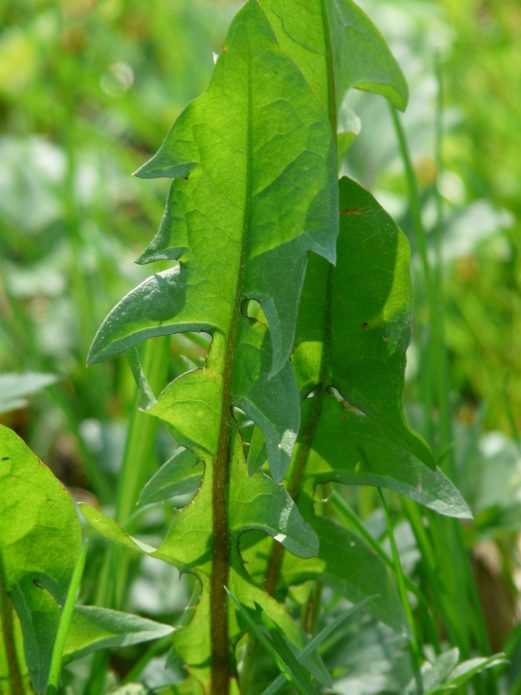

Dandelion is not only an annoying weed; it can be used to prepare "green fertilizer" and infusion to protect fruit trees from gall mites


Calendula is not only an ornamental, but also a very useful plant.


Potato tops for the preparation of the infusion must be absolutely healthy, otherwise there is a risk of spreading the infection throughout the garden
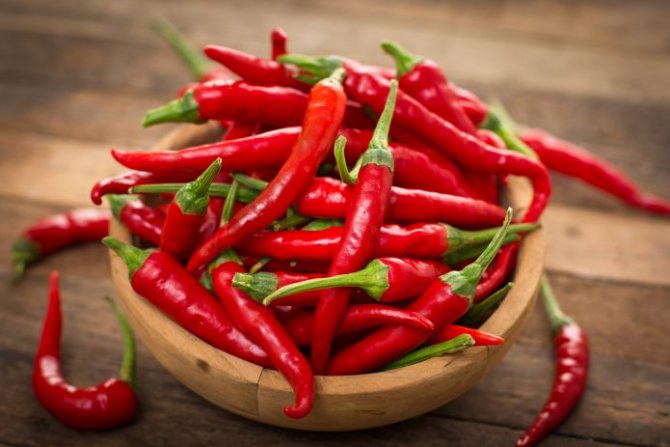

Hot chili peppers are not to the liking of many pests
The shelf life of the finished formulations is no more than a day. Processing is carried out only in cloudy weather.
Video: ways to protect fruit trees from gall mites
The harm of the Gauls and the fight against them
Galls grow from plant parts and therefore require nutrients like other cells. Therefore, in fact, these formations waste vital nutrients, which negatively affects plant growth. This can become a serious problem when galls are formed in large numbers on very young plants.
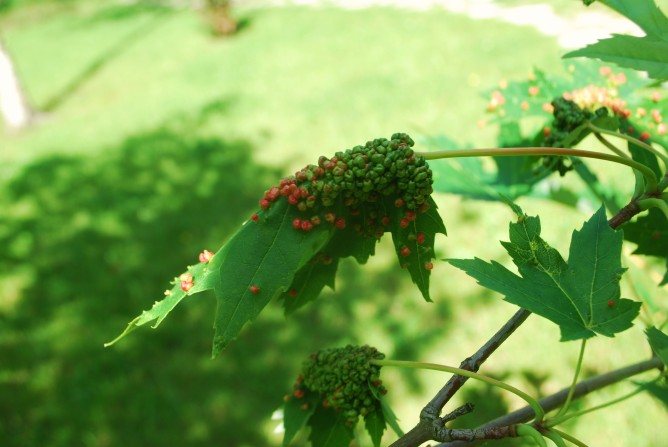

The plant can also suffer if gall mites have taken root in abundance for several years in a row on young trees, however, in most cases, galls do not harm crops enough to remove significant attention. Therefore, as noted above, the control of pests that contribute to the formation of galls need not start.
If necessary, chemical insecticides are a good option, but are often ineffective as timing is critical. For the treatment to show a good result, spraying the leaves should be timed to the initial stage of mite activity before the gall formation begins. Once the galls begin to form, they protect the pest and it is too late for treatment.
Agrotechnical methods for prevention and resistant varieties of pears
The main goal of such agrotechnical measures is to create uncomfortable conditions for the gall mite for life and reproduction:
- When fertilizing fruit trees, do not overdo it with phosphorus-containing dressings. An excess of this macronutrient in the soil and wood tissues attracts the gall mite.
- Carry out a sanitary pruning of the tree annually, clean off layers of dead bark from the trunk, remove all plant debris from the trunk circle (infected leaves and fruits must be burned), loosen the soil deeply. This will deprive the pest of suitable wintering sites. In autumn, whiten tree trunks by adding a 2% solution of Bordeaux liquid or copper sulfate to the lime solution. The caustic substance eats away at the mucous membranes of the mites.
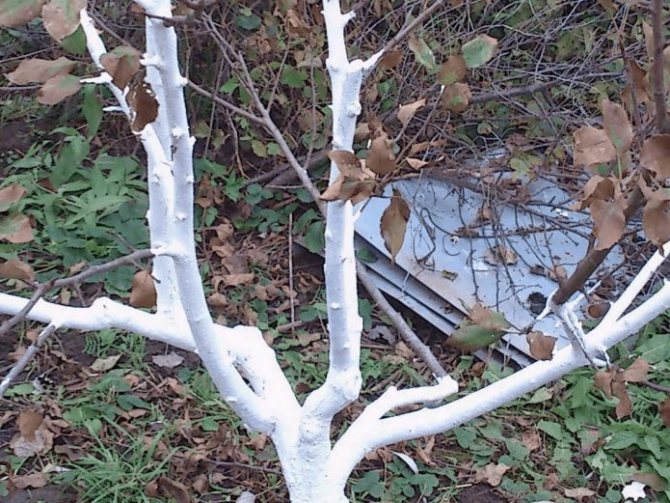

A caustic whitewash compound prevents gall mites from settling on a tree for wintering
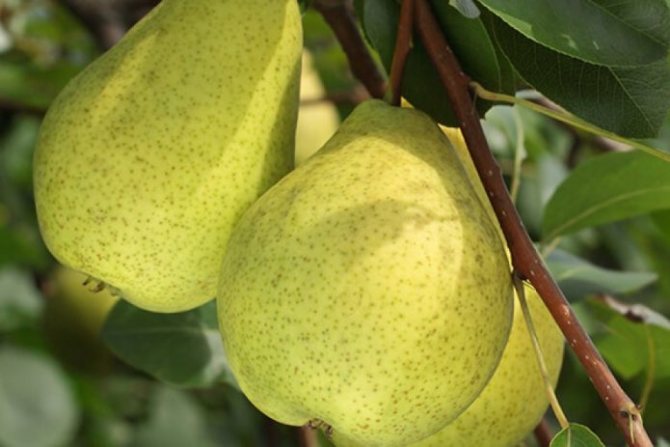

Pear Fairy - one of the varieties immune to gall mite
The attacks of gall mites greatly weaken the pear tree - it becomes more susceptible to the vagaries of the weather, and is more likely to get sick. To get rid of a pest, an integrated approach is needed. And, of course, prevention is very important - it is easier to prevent a pest attack than to try to remove it later.

